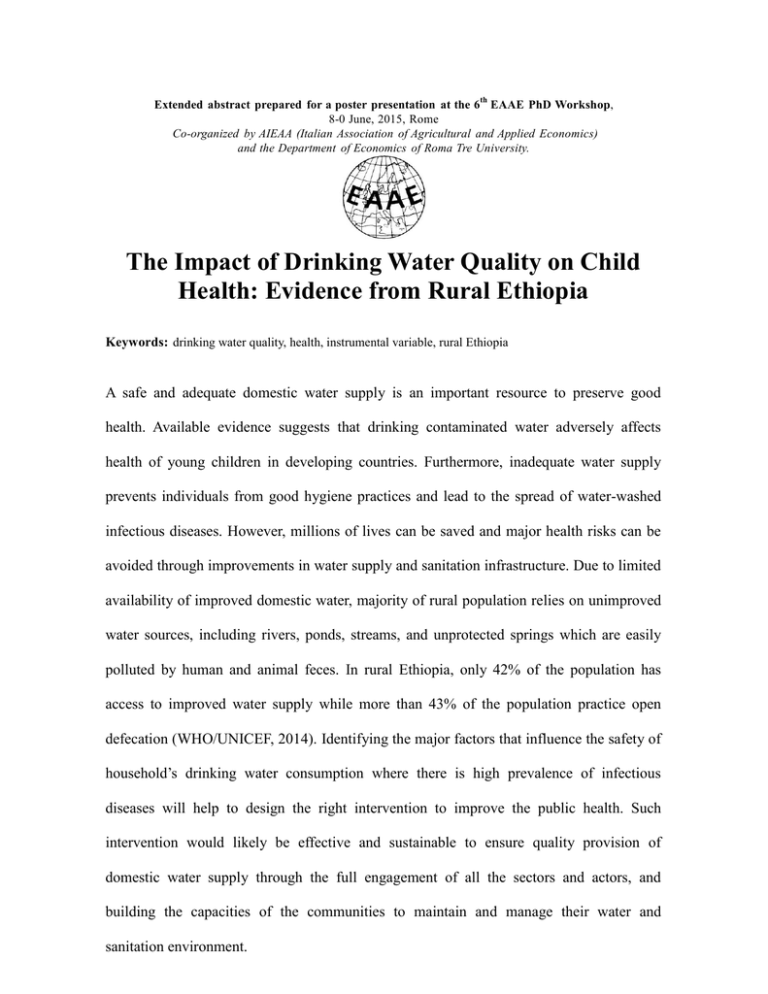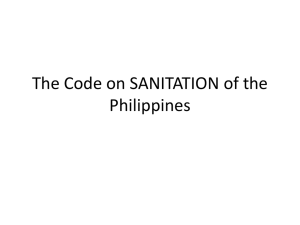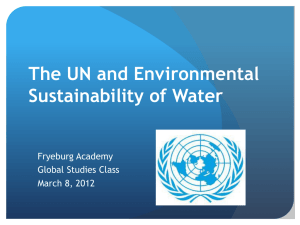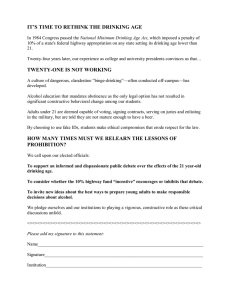Extended abstract prepared for a poster ... EAAE PhD Workshop
advertisement

Extended abstract prepared for a poster presentation at the 6th EAAE PhD Workshop, 8-0 June, 2015, Rome Co-organized by AIEAA (Italian Association of Agricultural and Applied Economics) and the Department of Economics of Roma Tre University. The Impact of Drinking Water Quality on Child Health: Evidence from Rural Ethiopia Keywords: drinking water quality, health, instrumental variable, rural Ethiopia A safe and adequate domestic water supply is an important resource to preserve good health. Available evidence suggests that drinking contaminated water adversely affects health of young children in developing countries. Furthermore, inadequate water supply prevents individuals from good hygiene practices and lead to the spread of water-washed infectious diseases. However, millions of lives can be saved and major health risks can be avoided through improvements in water supply and sanitation infrastructure. Due to limited availability of improved domestic water, majority of rural population relies on unimproved water sources, including rivers, ponds, streams, and unprotected springs which are easily polluted by human and animal feces. In rural Ethiopia, only 42% of the population has access to improved water supply while more than 43% of the population practice open defecation (WHO/UNICEF, 2014). Identifying the major factors that influence the safety of household’s drinking water consumption where there is high prevalence of infectious diseases will help to design the right intervention to improve the public health. Such intervention would likely be effective and sustainable to ensure quality provision of domestic water supply through the full engagement of all the sectors and actors, and building the capacities of the communities to maintain and manage their water and sanitation environment. Gaining insight from the current water and sanitation problems in Ethiopia, we examine the impact of contaminated domestic water use on child health and nutrition outcome. While achievement on improved water sources coverage has been applauded, the issues of water quality particularly in the rural setting of developing countries are still neglected. Considering the limited studies on the quality of drinking water on health and nutrition, this study aims to shed more light on those issues. This study employed instrumental variable estimation and regression analysis to estimate child health status. This study used primary sources of data in the analysis. Over a five months period (February to June 2014), a household survey has been conducted in rural area of Fogera and Mecha districts of Ethiopia. 454 agricultural households were randomly selected using a stratified multi-stage cluster sampling technique. The survey collected a range of information including demographic characteristics, household members’ health status, consumption and expenditure, time and labor use, land and other asset holdings and income sources, household’s drinking water supply and sanitation facilities, knowledge and practices concerning hygiene. In addition to household survey, one particular innovation of the study is the water quality testing was conducted both at household’s water storage and community water sources to determine the level of Escherichia coli (E. coli) bacteria– as measured by number of E. coli bacteria (cfu/100ml). The current WHO/UNICEF’s JMP standard of ‘improved’ water sources, water safety is not account for so it does not reliably predict the microbial or physiochemical level of the water. Moreover, studies indicated that water collected from improved sources often re-contaminated by fecal matter during transportation and storage (Wright et al., 2004). In addition, anthropometric measurements such as height and weight were also collected for children under-five years of age. The data show that 50% of our sample households have access to improved water supply such as public standpipe and protected well/spring, while 57% of households surveyed still practice open defecation. On the water quality aspect, we found that 58% of households in the sample have their water contaminated with E. coli. In addition, the data revealed that the stored drinking water was contaminated with E. coli in 43% of households with access to improved drinking water and 73% of households with no access to improved drinking water. Following Demographic and Health Survey, the diarrhea prevalence is a self-reported by the mother or caretaker of child under five years for symptoms of three or more loose or watery stools per day or the present of blood in stool. The prevalence of diarrhea for children of under -five years in the previous two weeks of the survey is 16%. The prevalence of underweight and stunting based on the anthropometric measurement results for under-five children is 27% and 35% respectively. The findings suggest that older children, children with preventative medical care, children with older mother and exclusive breastfeeding are less likely to have diarrhea. Stored drinking water is less likely to be contaminated with fecal matter in the households with better garbage disposal pattern, fetching water from improved sources and lower water collection frequency per week. Controlling for socio-economic variables, the estimation results show that water quality is associated with diarrhea prevalence. While we found no variation on child diarrhea on the improved or unimproved water sources, households having water sources on the premise have less diarrhea prevalence. While increasing coverage of improved water supply is a must, findings of this study suggest the importance of quality of drinking water for better child health and nutrition outcome. Reference [1] Wright, J., Gundry, S., & Conroy, R. (2004). Household drinking water in developing countries: a systematic review of microbiological contamination between source and point-of-use. Tropical medicine and international health 9: 106-117. doi: 10.1046/j.1365-3156.2003.01160.x [2] WHO/UNICEF (2014). Progress on Drinking Water and Sanitation: 2014 Update. New York, NY, USA, United Nations Children’s Fund (UNICEF); Geneva, Switzerland, World Health Organization (WHO). 1







